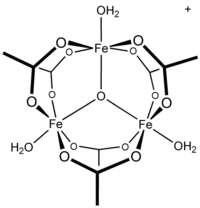
Photo from wikipedia
Nonheme iron(III)-superoxo intermediates are generated in the activation of dioxygen (O2) by nonheme iron(II) complexes and then converted to iron(IV)-oxo species by reacting with hydrogen donor substrates with relatively weak… Click to show full abstract
Nonheme iron(III)-superoxo intermediates are generated in the activation of dioxygen (O2) by nonheme iron(II) complexes and then converted to iron(IV)-oxo species by reacting with hydrogen donor substrates with relatively weak C-H bonds. If singlet oxygen (1O2) with ca. 1 eV higher energy than the ground state triplet oxygen (3O2) is employed, iron(IV)-oxo complexes can be synthesized using hydrogen donor substrates with much stronger C-H bonds. However, 1O2 has never been used in generating iron(IV)-oxo complexes. Herein, we report that a nonheme iron(IV)-oxo species, [FeIV(O)(TMC)]2+ (TMC = tetramethylcyclam), is generated using 1O2, which is produced with boron subphthalocyanine chloride (SubPc) as a photosensitizer, and hydrogen donor substrates with relatively strong C-H bonds, such as toluene (BDE = 89.5 kcal mol-1), via electron transfer from [FeII(TMC)]2+ to 1O2, which is energetically more favorable by 0.98 eV, as compared with electron transfer from [FeII(TMC)]2+ to 3O2. Electron transfer from [FeII(TMC)]2+ to 1O2 produces an iron(III)-superoxo complex, [FeIII(O2)(TMC)]2+, followed by abstracting a hydrogen atom from toluene by [FeIII(O2)(TMC)]2+ to form an iron(III)-hydroperoxo complex, [FeIII(OOH)(TMC)]2+, that is further converted to the [FeIV(O)(TMC)]2+ species. Thus, the present study reports the first example of generating a mononuclear nonheme iron(IV)-oxo complex with the use of singlet oxygen, instead of triplet oxygen, and a hydrogen atom donor with relatively strong C-H bonds. Detailed mechanistic aspects, such as the detection of 1O2 emission, the quenching by [FeII(TMC)]2+, and the quantum yields, have also been discussed to provide valuable mechanistic insights into understanding nonheme iron-oxo chemistry.
Journal Title: Inorganic chemistry
Year Published: 2023
Link to full text (if available)
Share on Social Media: Sign Up to like & get
recommendations!